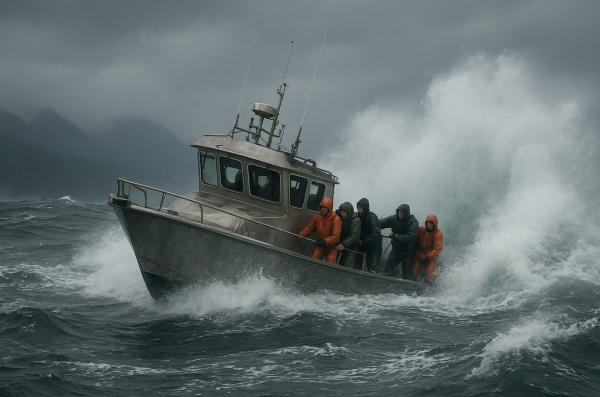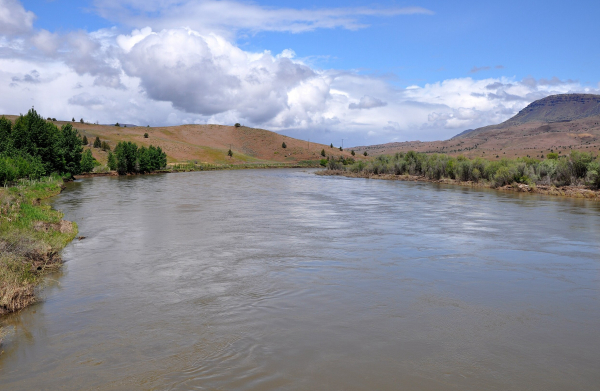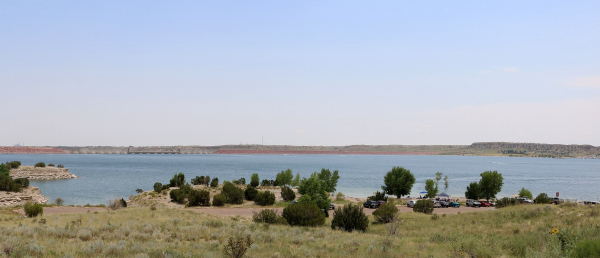
In terms of weather, it’s always better to be home wishing you were out on the water than out on the water wishing you were home.
When the air cools and the crowds thin, fall and early winter offer some of the finest fishing of the year. Bass chase shad along windswept points, trout gorge before ice-up, and king mackerel swarm along the coasts headed south. But the same shifts that turn fish aggressive can turn conditions dangerous. Every year, anglers underestimate how fast a “good fishing day” can become a rescue—or recovery—mission.
In July this year, a 28-year-old Portland angler lost his life on Oregon’s John Day River. He was fishing from the bank on what began as a calm summer morning with his family. But upstream storms had pushed the river higher and faster than normal. When he waded out to unhook a snag, the current swept him off his feet. Despite frantic efforts from relatives and park staff, he was gone before rescuers arrived. The river’s deceptively strong flow—fed by weather that seemed distant—was all it took.

A month earlier in Colorado, three anglers on 4,600-acre Lake Pueblo, south of Colorado Springs, launched in moderate wind to fish for wipers and smallmouths. Within an hour, gusts topped 30 mph. The lake turned into a washing machine of whitecaps. Their aluminum boat flipped, throwing all three into cold water. Two made it to shore; one didn’t. None were wearing life jackets. It was the second fatality there in just a few weeks, both tied to sudden weather spikes.
And in Alaska, a charter fishing trip near Sitka ended in disaster when a 30’ offshore vessel flooded and capsized in rough seas, killing five people, including a visiting couple from Hawaii. Investigators believe heavy rain and wave action overwhelmed the scuppers, allowing water to accumulate on deck until the boat rolled. Even an experienced captain couldn’t overcome that combination of wind, sea, and cold.
These tragedies weren’t freak accidents—they were the result of common mistakes anglers make every fall and winter. As temperatures drop, so does our margin for error. Cold air, cold water, and fast-changing weather patterns multiply risk on every kind of fishing trip, from a kayak on a small lake to a center-console offshore.
The Hidden Traps of the Cold Season
By late October, fronts start pushing across most of the country every few days. A calm, sunny morning can turn into a whitecapping blow by noon. Inland lakes develop strong temperature gradients, causing fog and wind shifts that confuse even experienced boaters. And in coastal zones, outgoing tides plus a north wind can create steep, breaking waves at inlets that have flipped many small craft.
Cold water is a killer. Once water dips below 60 °F, even a fit adult can lose swimming ability in minutes. Muscles seize, breathing falters, and hypothermia follows fast. The National Weather Service reports that most boating drownings happen in water under 70 °F—and most victims aren’t wearing life jackets.
It’s not just small boats that suffer. Larger vessels can get in trouble when wind-driven waves fill decks, when bilge pumps clog, or when captains push through inlet bars that look tame from a distance but build into breaking surf over shallow bottoms.
“It’s usually not one big mistake,” says retired Coast Guard rescue swimmer Mark Sanchez. “It’s three or four small ones—missing a forecast update, running too long in rough water, not wearing a PFD—that add up to a tragedy.”

Reading the Weather, Not Just the Bite
Most of us check the fish reports before we head out. Fewer check the hourly wind and barometric trend. Yet in fall and winter, those details can become a matter of life and death. A sharp barometer drop usually means a front is near; winds will shift, pressure will rise fast behind it, and waves will stack up.
Apps like Windy, NOAA Marine Forecast, and MyRadar now make it easy to see pressure and wind forecasts at specific spots and times. Use them religiously—and check during the day for changes.
Dress for immersion, not just comfort. A sunny 55-degree day can feel fine in the boat, but if you end up overboard in 50-degree water, you have less than ten minutes of functional time without proper layers or flotation.
Waders can become death traps unless you use a tight belt and PFD. And kayakers should treat every cold-weather launch like a survival situation—dry suit or wetsuit, always a PFD, and a plan to re-enter the craft fast. As experienced ‘yakkers say, it’s not “if” you will capsize, but “when”—it happens to us all sooner or later.
Fall offers trophy potential and near-empty waters, but it also demands respect. The same fronts that ignite the bite can also take lives. If you’re planning late-season trips, make your decisions like a pilot, not a gambler.
— Frank Sargeant
Frankmako1@gmail.com